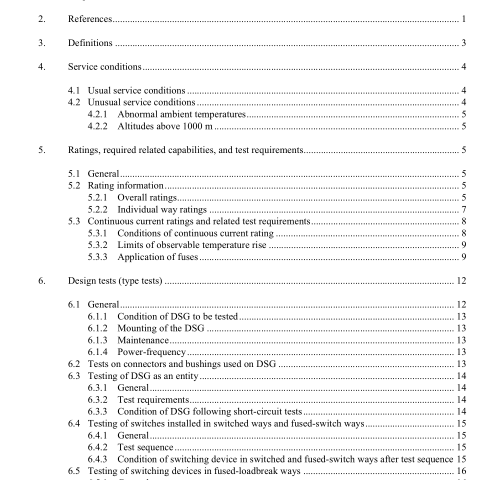IEEE C37.74-2003 pdf download.IEEE Standard Requirements for Subsurface, Vault, and Pad-Mounted Load-Interrupter Switchgear and Fused Load-Interrupter Switchgear for Alternating Current Systems Up to 38 kV
4. Service conditions
4.1 Usual service conditions
Apparatus conforming to this standard shall be suitable for operation at nameplate rating provided that a) The ambient air temperature is not above 40 °C or below –30 °C.
b) The altitude does not exceed 1000 m.
c) The subsurface or vault switchgear that is installed in a below-grade enclosure is subject to occasional flooding to a depth not exceeding 3 m above the top of the switchgear.
NOTE—Fuse time-current characteristics and continuous current ratings are affected by temperature; see EEE Std C37.48-1997.
4.2 Unusual service conditions
Unusual service conditions shall include, but are not limited to, service conditions that exceed the conditions
defined in 4.1 or extremes in
a) Duty cycle or unusual frequency of operation
b) System conditions including high harmonic content currents and voltages
c) Site conditions
d) Shock, vibration, or tilting
e) Damaging fumes, vapors, or corrosive liquids
f) Excessive or abrasive dust
g) Explosive mixtures of dust or gases
h) Salt air or extreme humidity
i) Flooding, including long-term flooding of submersible equipment, or flooding to a level that exceeds 3 m above the top of the submersible switchgear Unusual service conditions should be brought to the attention of the equipment manufacturer to define or pre- vent loss of performance or service life, if any, from specified values. Applicable standards such as standards for altitude correction should be used when available.
4.2.1 Abnormal ambient temperatures Distribution switchgear (DSG) may be applied at higher or lower ambient temperatures than specified. However, performance may be affected, and special consideration shall be given to these applications.
4.2.2 Altitudes above 1000 m DSG may be applied at altitudes higher than 1000 m; however, the basic impulse insulation level, rated max- imum voltage, and rated continuous current may be reduced. The rated interrupting current, related required capabilities, and rated interrupting time are not affected by altitude. Altitude correction factors are being studied by the Switchgear Committee. In the meantime, users should consult the manufacturer for appropri- ate derating when the equipment is applied above 1000 m. Refer also to Annex B.
5. Ratings, required related capabilities, and test requirements 5.1 General The ratings designated in this standard are preferred and are not considered restrictive. Nonpreferred ratings based on performance are acceptable under provisions of this standard when accepted by the equipment user. The ratings of the DSG are designations of operating limits under specified conditions, such as ambient temperature and temperature rise, and include ratings indicated in 5.2.
5.2 Rating information The ratings shall include overall ratings of the DSG and ratings of individual ways. See Table 1 for preferred rated values.
5.2.1 Overall ratings The overall ratings of DSG shall include the following:
a) Rated power-frequency
b) Rated maximum voltage
c) Rated lightning impulse withstand voltage
d) Rated power-frequency withstand voltage
e) Rated short-circuit current
5.2.1.1 Rated power-frequency
The rated power-frequency is the frequency at which the DSG and its components are designed to operate. The preferred rated power-frequencies are 50 Hz or 60 Hz.
5.2.1.2 Rated maximum voltage
The rated maximum voltage of DSG shall be the voltage of the way with the lowest rating. Three-phase DSG containing one or more ways with components rated for phase-to-ground voltage (maximum voltage divided by 1.732), such as fuses, single-phase switches, or fused-loadbreak devices, shall have the designa- tion “Grd-Y” (grounded-wye) added to the rated maximum voltage. The application of Grd-Y rated DSG should be limited to three-phase applications where the recovery voltage during switching or fault clearing across any Grd-Y rated way(s) does not exceed the phase-to-ground voltage rating of components and the three-phase system voltage does not exceed the rated maximum voltage of the DSG.IEEE C37.74 pdf download.IEEE C37.74-2003 pdf download
IEEE C37.74-2003 pdf download

Leave a Reply